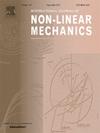两相,非局部,完全可变形梁的微扰方法
IF 2.8
3区 工程技术
Q2 MECHANICS
International Journal of Non-Linear Mechanics
Pub Date : 2025-06-02
DOI:10.1016/j.ijnonlinmec.2025.105136
引用次数: 0
摘要
局部弹性理论(内力在不可感知的分子间距离上是可感知的)在考虑非常小尺度的物体时面临不一致和局限性,即即使在线性设置中,其特征尺寸也不会比分子间长度大几个数量级。所谓的准连续体模型,保留了普通连续体力学的运动学和平衡原理,同时在本构层面上对内力进行了更丰富的描述,试图缓解这一问题。一个这样的模型,众所周知,并在最近几年普遍采用,是由于Eringen和线性表示应力应变的微分或积分形式,通过求助于一个核函数的卷积。该模型虽然在无限介质中是成功的,但在应用于有限域时可能遇到缺陷,需要施加不确定物理意义的“本构边界条件”。文献中的一系列替代建议试图克服这一困难;在目前的贡献中,我们应用了一个微扰过程来规避这一要求。我们将这种方法应用于分析完全变形梁的静力学和自由动力学的范例问题,并为基准情景提供了封闭形式的一阶表达式,避免了使用本构边界条件的必要性。纯柔性伯努利-欧拉梁的解可以作为这里提供的一种特殊情况得到。本文章由计算机程序翻译,如有差异,请以英文原文为准。
A perturbation approach to two-phases, non-local, fully deformable beams
The local theory of elasticity (inner forces are sensible at insensible intermolecular distances) faces inconsistencies and limitations when one considers bodies at very small scales, i.e., with characteristic dimensions that are not several orders of magnitude greater than the intermolecular lengths, even in a linear setting. The so-called quasi-continuum models, preserving the principles of kinematics and balance of ordinary continuum mechanics while incorporating a richer description of inner forces at the constitutive level, attempt to mitigate this issue. One such model, well-known and commonly adopted in the last years, is due to Eringen and linearly expresses stress in terms of strain in a differential or integral form, by resorting to the convolution of a kernel function. This model, while successful for infinite media, encounters possible drawbacks when applied to finite domains, necessitating the imposition of “constitutive boundary conditions” of uncertain physical meaning. A series of alternative proposals in the literature try to overcome such difficulty; in the present contribution, we apply a perturbation procedure that circumvents this requirement. We apply this methodology to analyse paradigmatic problems of statics and free dynamics for fully deformable beams, and we present closed-form first-order expressions for benchmark scenarios, avoiding the necessity to use the constitutive boundary conditions. The solutions for purely flexible, Bernoulli–Euler, beams can be attained as a particular case of those provided here.
求助全文
通过发布文献求助,成功后即可免费获取论文全文。
去求助
来源期刊
CiteScore
5.50
自引率
9.40%
发文量
192
审稿时长
67 days
期刊介绍:
The International Journal of Non-Linear Mechanics provides a specific medium for dissemination of high-quality research results in the various areas of theoretical, applied, and experimental mechanics of solids, fluids, structures, and systems where the phenomena are inherently non-linear.
The journal brings together original results in non-linear problems in elasticity, plasticity, dynamics, vibrations, wave-propagation, rheology, fluid-structure interaction systems, stability, biomechanics, micro- and nano-structures, materials, metamaterials, and in other diverse areas.
Papers may be analytical, computational or experimental in nature. Treatments of non-linear differential equations wherein solutions and properties of solutions are emphasized but physical aspects are not adequately relevant, will not be considered for possible publication. Both deterministic and stochastic approaches are fostered. Contributions pertaining to both established and emerging fields are encouraged.

 求助内容:
求助内容: 应助结果提醒方式:
应助结果提醒方式:


